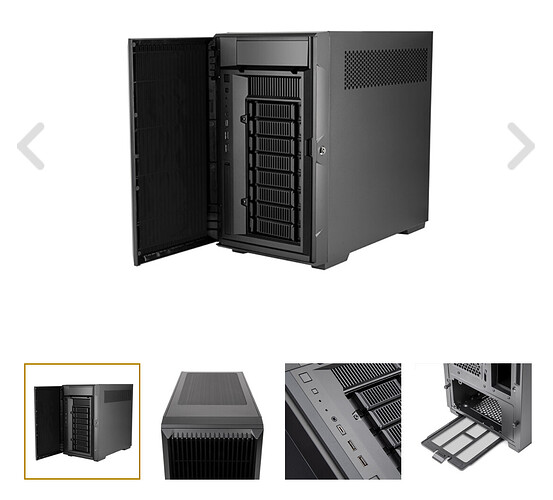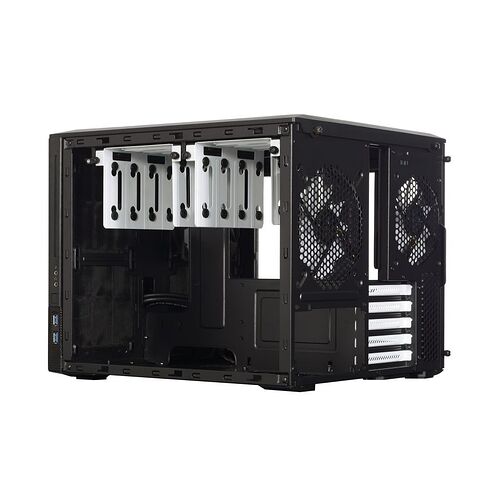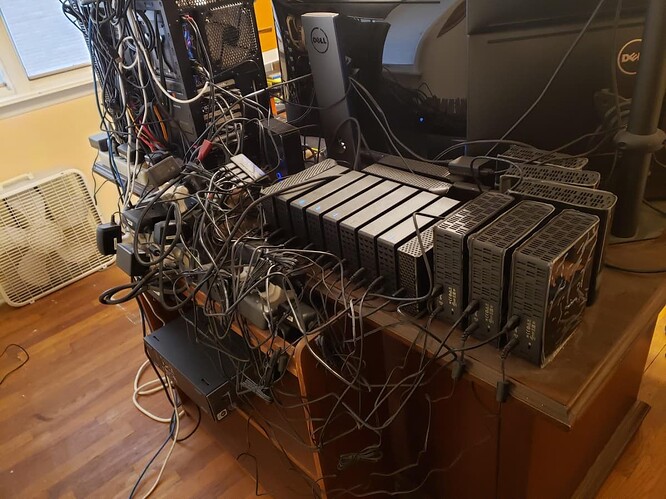And the UNAS has a “with PSU” option
I see what you did there… the meme is @winnielinnie ’s


In the 40L category this one is actually getting good reviews.
8-bay SAS-12G / SATA-6G hot-swappable high performance Micro-ATX NAS chassis
39.64L
CS382, supports big GPU and Radiators too.
And has a 5.25” meaning you can add 4 2.5” removable bays and has an optical slot too!
I made a thread for this already ![]()
I like the Node. You can get 8 drives in there without a sweat, +2 more if you mount on the bottom. Its not “hot swappable” although the side comes off pretty easy for easy access to any problematic drives. Its right at 40L, but is spacous on the inside and can be combined with most MB’s / GPUS easy enough. Its around $130 shipped but can be had for sale. Seen a TON of HT builds with this because it has a nice WAF which admittedly is not that important for servers. That said, I am certain Stux, Dan and Etorix have servers in their master bedrooms, right? ![]()
Living room.
And WAF was why the Node 304 ![]()
Likewise.
Bedroom? No way!
But the backup server is in the nearby dressing room. The main server is in the living… but it’s flash only, so no spinning noise.
My Node 804 was retired and its drives moved to a PC-Q26B, which is distinctly quieter. The 804 has good cooling, but the top mesh means that drive noise goes straight out of the case
I like these cases.
But there is something charming about the mad scientist rats nest home server get up. ![]()
That looks like you’ve had Uncle Fester’s ferrets build the thing.
Its not actually mine, saw it somewhere. I just thought the picture was hilarious. It probably exists, but there needs to be some kind of 5v-12v squid thing that can feed a lof the low amp peripherals in computer setups all at once. The wall warts are ALWAYS the biggest PITA to make your wires look clean.
OK, reanimating this necro thread with a new addition, hear me out before you laugh yourself out the door. This is just a thought experiment were I to replace the extant motherboard I have here today.
The aim is for a server that can handle up to 16 SATA drives, in addition to various boot, SLOG, etc. realities. At the same time, I am looking for something that will consume less power than my extant D-1537 rig, with the possibility of putting in a more performant chip, should the need arise (like enterprise-ready VMs, for example).
- MSI Motherboard - D3052 - Ryzen AM5, PCIe 5.0x16 and PCIe 5.0x4 slot, onboard Intel 810 SFP28
- Low Power Ryzen Pro / EPYC CPU
- Lenovo 430-16i or like LSI-based HBA, can be fit into 4x or x16 slot since HDDs won’t saturate it.
- 22110 PCIe 4.0x4 m.2 slot for my Optane SLOG (3.0x4)
- 128 GB, DDR5, ECC RAM
Thoughts?
I don’t see how an AM5 APU is going to use less power than a D-1537.
The HBA and Optane SLOG are not a good start for low power—although the HBA is pretty much needed for 16 drives.
All good points. Like a I said, just a thought experiment for a board if and when my embedded board dies. There is little out there that is optimized around 14-drives worth of SATA file storage, a SATADOM, etc. and I thought this motherboard was likely the best solution for my use case. I also looked around the LGA1700 form factor but wasn’t left too happy. Not enough PCIe lanes to make it viable in the long run like this board (as limited as it is).
If you can squeeze it to 12, then A2SDi-H-TF/TP4F just fit. Onboard 10G (including SFP+ with the TP4F), PCIe x4 for the SLOG and M.2 x2 for boot. (You knew this of couse.)
Next generations of embedded boards are a disaster. Atom C5000 (A3SPI) only have a PCIe x2 electrical slot (in x8 physical) for the HBA. Atom P5000 (A3SSV) does provide one genuine x8 slot for the HBA and one x4 for the SLOG—and plenty of PCIe 2.0 x2 ![]() M.2 slots for redundant boot. 55 W TDP, hoping it idles well under that.
M.2 slots for redundant boot. 55 W TDP, hoping it idles well under that.
“Thanks” to Xeon 6, the latest generation of X1_SDV boards are now 145 W to 235 W TDP affairs… ![]()
So, I suppose that AM5 Pro APUs are a fair option. I’d like to see motherboards with a pair of x16/x8 + x0/x8 slots (HBA + NIC or whatever) rather than a single x16 though. Workstation H13SAE-MF appears to be the only server-grade offer for now.
Another option I have looked into is AM4 platforms because they have a wider availability of unlocked Pro -G and -GE CPUs like the Ryzen Pro 5650GE. So here are a couple of additional thoughts:
- Motherboard: Asrock Rack B550D4U-2T, features 6 SATA ports (of which one is SATADOM), One PCIE 4.0x16, one PCIe 4.0x4 slot, 1 m.2 PCIe 3.0x4 or SATA, Copper 10Gbe via Intel x710-AT2 combined with a LSI 3000-8i, get the 14 SATA drives I’m looking for. The 3008 can likely live just fine in the PCIe 4.0x4 since I’m only hanging spinners off of it. That leaves the x16 slot free for NVME in the future (the PCIe x16 slot can allegedly bifurcate down to 4x4).
- For now, my AM4 CPU of choice would be a 5650GE, which is on the QVL list, low power, but only allows PCIe3.0 operation for the PCIe slots. For PCIe 4.0 operation, you need a later Vermeer / Matisse generation CPU but those are also more power hungry (at least the ones on the QVL list).
One concern I have with the above motherboard is that all the on-board SATA drives (6), the x710-AT2 10GbE NIC, and the 3.0x4 m.2 slot share the same PCIe 3.0x4 bus from the B550 to the CPU. That gives me pause, especially if the m.2 PCIe 3.0x4 slot is used for a SLOG.
Another option as an alternative to the MSI D3052:
- MSI D3051 or Gigabyte MC13-LE1. Both boards offer X710-AT2 Intel 10GbE Copper NICs, B650 chipset, 1x PCIe 5.0x16, 1 PCIe 4.0x4.
Where the two differ is that the MSI offers four SATA3 ports (including a SATADOM) plus 2 SATA2 Ports. The Gigabyte only offers 4 SATA3 ports. For the MSI, it shares PCIe lanes with one of the two M.2 interfaces (PCIe 4.0x4). The Gigabyte only offers one m.2 PCIe 4.0x4 slot. Both use a ASpeed 2600 IPMI. The MSI seems like the better option re: SATA and m.2, though the second m.2 is likely less than useful given that it’s muxed with the PCIe 4.0x4 slot.
The only SuperMicro entry in this arena is the H13SAE-MF, which is pretty bare. It plays interesting games with a MUX to allow two 5.0x8 PCIe, one PCIe4.0x4 slot along with a m.2 4.0x4 hanging off the CPU, the other from the B650. Given the 4.0x4 connection from the B650 to the CPU, there seems to be ample bandwidth. Anyhow, this setup would require a SFP+ NIC and a 3000-8i LSI HBA to get close to the MSI for this use case. After HBA and NIC, that only leaves one 5.0x8 slot left open for the future, which is less than the MSI / Gigabyte options.
Comes down to how one wants to slice the onion, I guess. None of the AM5 options look that attractive at the moment as far as low power is concerned. But at least they seem to be more future-proof assuming you want to make a change to NVME in the future.
Overall, I still prefer the D3052 because it’s more honest (no MUX for the second PCIe 4.0x4 slot, only one m.2 4.0x4). What is not clear to me is whether all AM5 processors (i.e. Ryzen 5 Pro 8600G or GE ) work in this motherboard, or just the 4xx4, 4xx5, 79xx, and 9xxxX series listed in the AVL. This youtube video suggests that at least the Pro 7600 will work…
Only with a CPU; APUs are limited to x8x4x4. Which is enough to have a low-profile HBA on CPU lanes alongside a pair of M.2 drives in a x8x4x4 riser.
The x4 link to the chipset is a weakness of AMD compared with latest Intel platforms (x8).
Using a HBA anyway allows to look into “X300” boards which do without a chipset (but I’d like to see at least full micro-ATX size and more slots, or more exposed I/O rather than just saving some PCB real estate).
Not to mention the onboard 25G… ![]()
I am perfectly content waiting for the current generation of boards to get older and more affordable. What’s disheartening is the lack of love for on-board SATA, but at the same time, my 2116 is a hot mess and likely consumes a lot more power than a 3x00-16i or later generation. That’s the beauty of stuff being a separate add-on vs. built-in, you can replace it!
That said, I really doubt I’d ever saturate a 25GbE NIC, rather I’d be taking advantage of a later, likely more power-efficient NIC chipset than the one found in my motherboard, just like the Intel 710 allegedly saves 1/2 power vs. the earlier 550 10 GbE copper NIC. I really prefer SFP+ over copper so that reason alone pushes me to the 25GbE board.
So do you think that a Pro 8600G would work in the D3052 even if it’s not on the qualified list? The Youtuber used a 7600 in his test, so that seems to suggest the D8600G would work?
This reminds me of a rant I made a few years ago:
I want an intermediate AMD CPU between desktop and server with:
- 40 or greater PCIe lanes, with good bifurcation options
- 4 memory channels, with ECC option, (and now DDR5’s 80 bit ECC option)
- 6 - 8 SATA, (some could be re-allocated to PCIe lanes)
- Core count as low as 2 and as high as 16, with hyper-threading
The AMD Threadripper were / are just too much. They include CPU core counts like 64. What I was suggesting was a server grade CPU, but lower power and capable for lower performance use cases. But, better than AMD’s AM4 & AM5 desktop offerings.
The Epyc 4004 is just not “it”, since it uses AM5 sockets which limits PCIe lanes, SATA ports and memory channels. Nor was the Epyc 8000 series this either.
Unfortunately this theoretical in-between desktop and server CPU would need a new socket.
It’s sort of like the Q26 case from Lian-Li, these kinds of solutions are hard to come by and often even if they do exist, they are unobtanium. The number of PCIe lanes (28?) in AM5 is still pretty attractive compared to what Intel has on offer, though some of the Intel offerings have pretty amazingly low idle power draws also. That’s where a modern SFP+ NIC and a decent recent HBA can really make for a sipping NAS that still offers a lot of SATA ports and 10GbE over SFP+. What the best implementation is depends a lot on the use case…
On the question of suitable motherboards for this thing, here’s a suggestion:
Only six SATA ports though.


